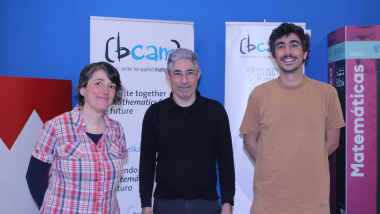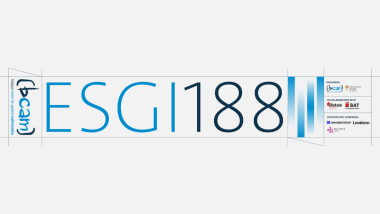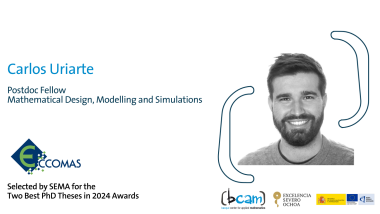Ana Justel: "After 7 campaings in Antarctica I'm much more aware of how much a piece of data costs"
Ana Justel is a lecturer in Statistics in the Department of Mathematics at the Universidad Autónoma de Madrid (Spain). Her research has a markedly multidisciplinary character, with contributions in mathematical and computational statistics, as well as in biology, ecology and economics. She has published more than 50 scientific papers and dissemination articles and has carried out research and teaching stays at several foreign universities, including Duke University (USA), Université Paris-Dauphine (France) and Université Catholique de Louvain (Belgium). She is currently co-principal investigator of the MICROAIRPOLAR Antarctic Research Project, funded by the State Research Agency (AEI). For 15 years, she has participated in the design of the experiments and the data collection of seven campaigns of the Spanish Antarctic Program, at the Byers International Camp and BIO Hespérides. On Friday, May 18th she visited the Basque Center for Applied Mathematics to offer one of the BCAM-UPV/EHU seminars on Applied Statistics and we took the opportunity to ask her some questions about her scientific work and the project she currently runs in Antarctica.
- Tell us a little about your professional career, why did you decide to study Mathematics and why did you choose Statistics?
So much has happened since then, I can hardly remember how I got into math. I liked all the sciences, but Mathematics amused me more than any other. Statistics attracted me because of their proximity to real problems, and because they’re everywhere. I saw them as an open window to do great scientific and social world. When I finished my degree, I went to do a doctorate in economics.
- You combine teaching at the Universidad Autónoma de Madrid with scientific expeditions to Antarctica. How does a mathematician end up in the South Pole?
A little by chance and a lot by enthusiasm and curiosity for all sciences. I was asked to help analyse data from a project they were working on in Antarctica, and I simply said yes. I finally ended up taking the data with my bare hands. It’s been seven campaigns already, and by now I'm much more aware of how much a piece of data costs.
Reports about climate change are based on millions of data, mathematical models and statistical tests
- You just got back from AEMET's 31st Antarctic Campaign. What can you tell us about the experience? What is life like in such extreme conditions?
Life there is very intense, we have almost no time to think about the bad weather and the many inconveniences of living in a campsite in a specially protected area of Antarctica. We have to take advantage of every minute to do the field-work, which we always plan beyond our means, and which the weather doesn’t always allow for. This campaign has been a little tougher than the previous ones. The end of the season was very close and each day was shorter and with less time than the previous ones. Moreover, the end of the campaign unfortunately came sooner than expected. In spite of everything, the curious thing is that after a few days there, we are all convinced of how good it is living at Camp Byers.
- You are the Principal Investigator of the MICROAIRPOLAR project. What does it consist of?
It is a multidisciplinary project in which the main objective is to study the dispersion and colonization capacity of airborne micro-organisms in Antarctica. In order to answer the question of how the colonization of newly exposed soils occurs due to the retreat of glaciers, which is becoming increasingly frequent due to climate change, we need to deepen our understanding of the movements of air masses in the polar regions and develop new statistical tools to deal with problems where a large volume of data is available. The team includes biologists, statisticians, computer scientists and meteorologists from the Antarctic group of the AEMET.
- What is your role in the project?
In projects with stays in the Antarctic bases and the Hespérides Ship, PIs have to organise their campaigns and participate in the coordination meetings of activities with other projects. We must define the objectives, draw up the protocols, transfer the materials to the ports where the ships leave from months before we do, buy the clothes, ask for the permits, make special reports, etc. And, of course, the most important thing is to coordinate and work actively on the campaigns and all the research before and after to achieve the scientific objectives. Not to mention all the bureaucracy associated with the research projects we usually undergo. Fortunately, I am not alone, I share the work with my colleague Antonio Quesada, who is the IP biologist, a great expert in biology in polar environments with a lot of Antarctic experience.
- Is Mathematics important in the fight against climate change? How can statistics contribute in this area?
The IPCC (Intergovernmental Panel on Climate Change) reports are clear, there is significant evidence that temperatures rise due to human action. The reports are based on millions of data, mathematical models and statistical tests. It is now time to join the entire scientific community in providing the tools for modelling and data analysis to anticipate and remedy the consequences that climate change will have on life on Earth.
- What are your future projects?
Right now, I am very focused on this project, which has just begun. It is an exciting challenge to work so closely with people from different disciplines and full of enthusiasm, it doesn't leave me much time to think about the future. Although in Antarctica it never stops, so we are already in the middle of organizing the next campaign. Our plan is to go again next February to Camp Byers to complete this year's work and we will also be sampling soil and airborne throughout the Antarctic Peninsula, for which we will have to work from the Hespérides Ship.
Related news
Zentroari buruz
Zentroari buruz
ESGI 188 (European Study Group with Industry) Bilbon izango da 2025eko maiatzaren 26tik 30era
BCAM pertsonak




